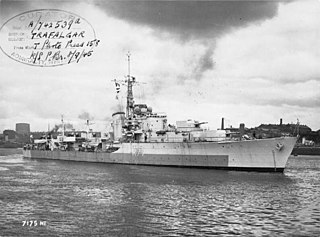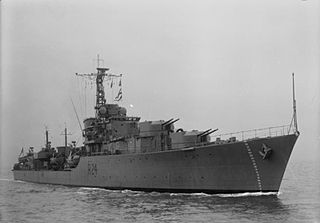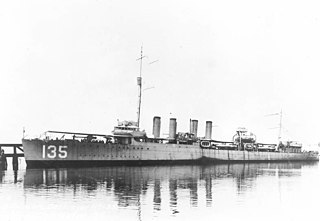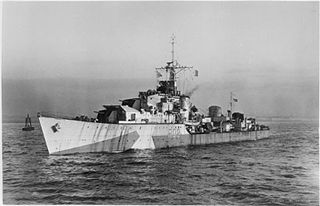
HMS King Edward VII, named after King Edward VII, was the lead ship of her class of pre-dreadnought battleships built for the British Royal Navy. Armed with a battery of four 12-inch (305 mm) and four 9.2 in (234 mm) guns, she and her sister ships marked a significant advance in offensive power compared to earlier British battleship designs that did not carry the 9.2 in guns. King Edward VII was built at the Devonport Dockyard, and was laid down in March 1902, launched in July 1903, and completed in February 1905.

HMS Loch Dunvegan was a Loch-class frigate of the British Royal Navy, named after Loch Dunvegan in Scotland. Launched in 1944, the ship saw service in the Second World War, and in the Mediterranean Fleet in the early 1950s, before being broken up in 1960.

The Battle class were a class of destroyers of the British Royal Navy (RN) and Royal Australian Navy (RAN), named after naval or other battles fought by British or English forces. Built in three groups, the first group were ordered under the 1942 naval estimates. A modified second and third group, together with two ships of an extended design were planned for the 1943 and 1944 estimates. Most of these ships were cancelled when it became apparent that the war was being won and the ships would not be required, although two ships of the third group, ordered for the RAN, were not cancelled and were subsequently completed in Australia.

HMS Trafalgar was a Battle-class destroyer of the Royal Navy (RN). She was named after the Battle of Trafalgar, a decisive British victory over a Franco-Spanish Fleet in 1805. Trafalgar was built by Swan Hunter on the Tyne. She was launched on 12 January 1944 and commissioned on 23 July 1945.

HMS Camperdown was a Battle-class destroyer of the Royal Navy (RN). She was named after the Battle of Camperdown, a naval engagement between the British and Dutch that took place in 1797, and which resulted in a British victory.

HMS Barrosa (D68) was a later or 1943 Battle-class fleet destroyer of the Royal Navy.

HMS Gravelines was a Battle-class destroyer of the Royal Navy. She was named after the Battle of Gravelines, which took place in 1588, resulting in the English Navy defeating the Spanish Armada. Gravelines was built by Cammell Laird of Birkenhead. She was laid down on 10 August 1943, launched on 30 November 1944 and completed on 14 June 1946.

HMS Solebay was a Battle-class destroyer of the Royal Navy (RN). She was named after the Battle of Solebay which took place in 1672 between an Anglo-French force and the Dutch Navy during the Third Anglo-Dutch War. Solebay was built by R. & W. Hawthorn, Leslie & Company Limited on the Tyne. She was launched on 22 February 1944 and commissioned on 25 September 1945.

The first USS Tillman (DD–135) was a Wickes-class destroyer in the United States Navy. She was named for Senator Benjamin Tillman. Transferred to the United Kingdom in World War II, she was commissioned in the Royal Navy as HMS Wells.

HMS Battleaxe was a Weapon-class destroyer of the Royal Navy, completed just after the Second World War.

HMS Daring was the nameship of the Daring-class destroyers authorised in 1944. Between 1953 and 1957 they were reclassified as "Darings" and not included in the destroyer total, but from October 1957 they reverted to classification as destroyers. Daring was built by Swan, Hunter and Wigham Richardson on the Tyne and engined by the Wallsend Slipway & Engineering Company. She was laid down on 29 September 1945; launched on 10 August 1949; and completed on 8 March 1952. She served five commissions, was placed in reserve in December 1968 and sold for scrap in 1971. She was the sixth ship of her name in the Royal Navy.

HMS Dainty was a Daring-class destroyer of the British Royal Navy. Ordered in 1945, she was built by J. Samuel White at their Isle of Wight shipyard, being launched in 1950 and completed in 1953.

HMS Broadsword was a Weapon-class destroyer of the British Royal Navy in service from 1948 and scrapped in 1968.

HMS Roebuck was an R-class destroyer of the British Royal Navy that saw service during World War II. She was the fifteenth ship to carry this traditional ship name, after a small deer native to the British Isles, which was used as far back as the reign of Queen Elizabeth I.

HMS Undaunted was a U-class destroyer of the British Royal Navy that saw service during World War II. She was later converted into a Type 15 fast anti-submarine frigate, with the new pennant number F53.

HMS Zest was a Z-class destroyer of the Royal Navy that saw service during World War II.

HMS Wrangler was one of eight W-class destroyers built for the Royal Navy during World War II. Completed in 1944, the ship spent most of the war in the Far East and escorted British aircraft carriers as their aircraft attacked targets in the occupied Dutch East Indies and in Japan itself. Wrangler was present in Tokyo Bay when the Japanese formally surrendered on 2 September 1945.

The second HMS Whirlwind was a W-class destroyer of the British Royal Navy and was built by Hawthorn Leslie and was launched on 30 August 1943. She saw service during World War II and the Cold War.

HMS Carysfort was a C-class destroyer of the Royal Navy. She was ordered in 1941, originally under the name HMS Pique.

The first HMS Walrus (D24) was a W-class destroyer of the British Royal Navy that saw service in the final months of World War I.




















